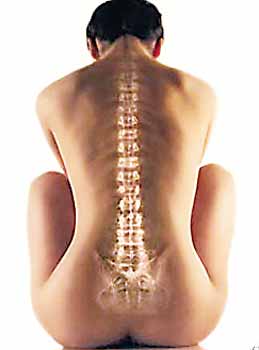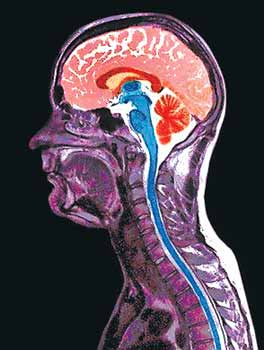Any 'body' know ?
By Smriti Daniel
Bodies are wonderfully mysterious things. They demand feeding and watering, and in return they allow us to vocalise bad jokes, perform complicated acrobatic feats, wink at cuties on the road, sleep like logs for hours on end and occasionally embarrass ourselves by farting in public.
The fact is, you'll live with and in your body all your life, but at many levels it may always be a stranger…capable of doing the most extraordinary things without so much as a "by your leave…"
While you may know that the typical human body contains one heart, 5.6 litres of blood, 206 bones, and some 100 billion brain cells, what do you know about the trickier components?
For instance, what the heck is a zygomatic? Take our quiz and test your knowledge of a few of the body's more obscure bits and pieces.
1. The longest and
largest nerve in the
human body is
the…
a) Spinal cord
b) Sciatic
c) Thoracic
2. If you met Hannibal
the cannibal and he
chose to take
your skin (minus you,
of course) and make a
run for it, he could be
carting around as much
as:
a) 11 kgs
b) 2.2 kgs
c) 1 kg
3. The subclavian is…
a) A small bone found below the collar bone
b) An artery attached to
the aorta
c) A viscous liquid that supports the kneecap
4. Blood is a liquid
organ
a) True
b) False
c) "It is against my reli gious principles to answer this question."
5. The laryngeal
prominence is more
commonly known as the:
a) Chin
b) Collar bone
c) Adam's Apple
6. The opening that
connects the esophagus
and stomach is called the
a) Gastric orifice
b) Cardiac orifice
c) Abdominal sphincter
7. Fingernails contain
Keratin, which is the
same stuff you find in...
a) Exoskeletons of
lobsters and beetles
b) Apple rinds
c) Rhino's horns and
dog's claws
8. Phalanges are
the technical term for…
a) Finger bones
b) Toe bones
c) Both finger and toe
bones
9. On the outside,
a protruding zygomatic
bone may look like…
a) Puffy cheeks
b) A cone-shaped head
c) Thick ankles
10. The hammer, anvil
and stirrup are three
tiny bones found in the
a) Nose
b) Ear
c) Throat
11. Blood in your renal
artery is travelling
to your:
a) Kidneys
b) Large intestines
c) Liver
12. The Circle of Willis
is…
a) The hole where the small and large
intestines meet
b) The common name for a female's birthing canal
c) A ring of arteries in the brain
13. One part of your body
reveals a unique
pattern that is many
times more detailed
than a thumbprint.
Which is it?
a) The swirls in your
ear
b) The pattern in your
retina
c) The distance between
your nose, eyes, and
mouth.
14.The thymus is
unique
because it is a:
a) Muscle with no apparent function
b) Gland that grows until puberty and
then shrinks into fat
c) Bone that everyone
has but only females make use of
15. Dentin and pulp are
the inner layers of
a) Your teeth
b) Your stomach lining
c) You cerebellum
Scoring:
Check your answers against the table given below to see how many you got right.
Consider yourself a doctor if you got all 15 correct, a medical student if you got 10 or more, a naturally gifted intellect if you got 5 or more.
However, if you got fewer than 5 correct, it might be a good idea to stick to playing 'doctor, doctor' with any gullible children of your acquaintance.
And stay away from sharp objects!
| Scoring Table: |
1. a) The sciatic nerve – the longest single nerve in the body – supplies nearly the whole of the skin of the leg, the muscles of the back of the thigh, and those of the leg and foot.
2. a) Talk about baggage.
3. b) The subclavian artery is a major artery of the upper thorax. Located below the clavicle (hence the name), it mainly supplies blood to the head and arms. The subclavian artery is not to be confused with the subclavian vein or the subclavian nerve.
4. a) Interestingly, blood has been widely used in art, and not just in the Hollywood variety. Artists have delighted in photographing it, painting with it and even using it in performances. Notably, a certain Marc Quinn has made sculptures using frozen blood, including a cast of his own head made using his own blood.
5. c) The term "Adam's apple," is pretty self explanatory. Webster's 1913 dictionary states that the term "… is so called from a notion that it was caused by the forbidden fruit, (an apple) sticking in the throat of our first parent [i.e. Adam in the Book of Genesis]."
6. b) The cardioesophageal junction, or cardiac orifice (the opening of the esophagus into the stomach) is encased in the portion of the stomach known as the cardia.
7. c) Keratins are a family of fibrous structural proteins; tough and insoluble, they form the hard but non-mineralized structures found in reptiles, birds, amphibians and mammals. They are rivalled in biological toughness only by chitin – found in the exoskeletons of lobsters and beetles.
8. c) The term phalanx or phalanges refers to a Greek army formation in which soldiers stand side by side, several rows deep, like an arrangement of fingers or toes.
9. a) Commonly referred to as the cheekbones, high zygomatic bones are seen as a sign of beauty in many cultures and are a characteristic of many a successful high-fashion model.
10. b) Only vertebrate animals (those with backbones) have ears, although many invertebrates are able to detect sound using other kinds of sense organs.
11. a) By it's very definition the word 'renal' means relating to the kidneys. In this case, a large portion of the blood sent out by the heart can pass through the renal arteries to be filtered by the kidneys.
12. c) The circle of Willis is a circle of arteries that supply blood to the brain. So who was Willis? An English physician who lived in the 17th century; first name: Thomas.
13. c) The blood vessel patterns of the retina and the pattern of flecks on the iris both offer unique methods of identification. Plus, the human retina is stable from birth to death, making it the most accurate biometric to measure.
14. b) The thymus grows between birth and puberty and then begins to atrophy, after which the organ is primarily replaced with fat in a phenomenon known as involution.
15. a) Dentin makes up the largest part of the tooth and is similar to bone. It is prone to severe cavities if not properly treated. Dentin protects the innermost part of the tooth, called the pulp, where each tooth's nerve endings are found.
|
|


